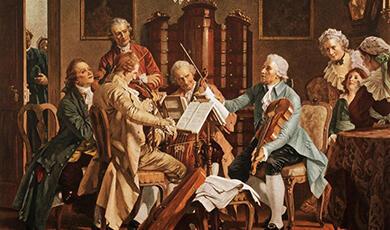The Colour Spectrum of Scales and Modes
Share
- Details
- Text
- Audio
- Downloads
- Extra Reading
A musical scale – a hierarchical collection of pitches spread over multiple octaves – is a fundamental building block in the creation of melodies and harmonies in a wide range of musical practices. But where do these scales come from? Are they invented or discovered?
This lecture looks at the history, theory and artistry of scale construction in a wide range of styles, and how each scale can, through ‘rotation’, form a colourfully expressive palette of modal colours.
Download Text
The Colour Spectrum of Scales and Modes
Professor Milton Mermikides
22 February 2024
First Steps
Every civilisation or culture we have so far discovered has music. Wherever there are people, there is music. Indeed music seems to be as important (in some cases more so) than many other common activities or ideas, including marriage, written language, the linguistic concepts of number, colour, relative direction (left and right), or tenses to express time. While it seems then that music-making is part of being human, it also appears that despite the stunning diversity of music through place and time, there are some broadly common themes and concepts, convergent ideas that recur so often that they might be almost innate and inevitable. One of these (overwhelmingly common if not universal) meta-concepts is that of a musical scale. We’ll define a scale for now quite broadly: a collection of pitches with a particular intervallic structure[1], providing a framework, alphabet – or ‘palette’ – for the creation of melodies and harmonies. And we know that this idea is ancient and embedded into many strands of musical history. We have an idea of what scales are used historically through instruments (e.g. the position finger-holes of the Ice Age mammoth-ivory flute (Schneider, 2004) in Lecture 1), notations (from music notation, transcriptions to treatises) and – as of the last century or so – recordings. What do we find in such musical artefacts?
The Roots of Scales
The Hohle Fels Pentatonic
Our first clues for historical musical scales come from the handful of bone flutes we have discovered in palaeolithic excavation sites. Although the musical use of some of the earliest objects is a matter of debate, objects that are undeniably flutes have been found from 40,000 years ago. The finger hole placement gives us strong (if not definitive) information about the prehistory of scales. Blown instruments are quite malleable in terms of pitch – notes can be significantly bent, or overblown to access the harmonic series – and so we cannot be entirely confident in the scales and their usage, but some key – and surprisingly resilient – themes emerge. A 35,000 year old flute (Hohle Fels Flute 1) delicately carved from the radial bone of a griffon vulture, boasts five beautifully sculpted fingerholes. The carving includes impressions for secure finger placement, as well as signs of their careful measurement. A replica of it can easily produce a very convincing and familiar pentatonic scale (in this case 6 notes from the root to the upper octave of an Eb major pentatonic). This scale – five notes spread quite evenly in singable 2nds and 3rds across an octave – can be impersonated on the black keys of the piano, and is perhaps the most prevalent, globally embraced and accessible scale on the planet. Its ever-presence in a huge range of eras and musical cultures suggests that it is unlikely to be just an idea that survived retelling, but was continually rediscovered, as if it is somehow innate. Where do these specific notes in this palaeolithic flute (and countless later examples) come from? Are they arbitrary constructions, or somehow naturally occurring? Let’s consider some possible explanations.
The pentatonic scale of the Hohle Fels flute reveals some common themes and ways to describe scales still in use today. Firstly it is cyclical (or at least closed) at the octave, all the fingerholes open is an octave (double the frequency) of the lowest possible note (all the fingerholes closed). By overblowing any of the notes they can also be taken up an octave. So although the term ‘scale’ implies a ladder of rising notes (as derived from the latin root scala), the overwhelming use of scales however treats a collection of notes more of like a cycle where they wrap round to the starting note an octave higher (with an identical name). When we make music we pick from notes in a circle, choosing octaves freely. We can in fact fuse the idea of scales as ascending a ladder and as arranged in a circle, by imagining a helix, with the notes ascending in a spiral. Looking from top down this gives us a circle (with all notes an octave apart in a row). But side on, we can recover the sense of ascension and distance across octaves.
The concept of octave equivalence helps explain why almost all musical cultures use a cycle of note names to categorise pitches, which repeats at the octave (A–G in Western notation, Do–Ti in solfege, Sa–Ni in Hindustani music etc.) rather than a long series of names without repetition. Middle C and a high C (and a low D and a high D) – if not the same – belong to the same category (also known as ‘pitch-class’). But why is the octave so common, and why does it imply a cyclicity? When we hear pitches together (or in close succession), they produce or imply specific pitch distances between them known as Intervals. Each interval has varying degrees of consonance and dissonance, basically how ‘smooth’ or ‘rough’ they sound. Figure 3 plots such a dissonance curve. One whole octave is represented with markers at 12-tone equal temperament and some representative harmonic ratios (which are often associated with relative consonance). As we increase the interval the experienced dissonance is not linear but has a series of peaks and valleys. Other than unison (two identical pitches), the octave (a doubling of frequency) represents the most consonant point on the curve. It is almost like an octave interval is equivalent (or near-identical) to its reference pitch. This is because every note has a pattern of harmonics above it (often at harmonic intervals[2]) radiating upwards from the played notes. Notes an octave apart share many of these harmonics and so essentially, have a similar sonic identity.
The remarkable consonance of the octave helps explain why our Paelolithic ancestor chose the outer two notes of the flute, but what of the other notes? There are several possible explanations, and one or more might be relevant. The major pentatonic is roughly approximated by the harmonic series (see Figure 4 lower right). We can also see that on the dissonance curve (Figure 3) the notes of the major pentatonic (Root, major 2nd (∆2), major 3rd (∆3), Perfect 5th (P5) and major 6th (∆6)) are quite close to valleys, points of low consonance. The circle representation (Figure 4, top middle) shows further insights. The notes of the scale are quite evenly spread across the octave. Not perfectly evenly but the pattern is significant. It is spaced apart in two interval parts - a ‘long’ minor 3rd (b3), and shorter interval of a major second (∆2). So if we consider a scale in terms of its constituent interval types, this only has two. It has simple (‘low entropy’) underlying language, like the dots and dashes of morse code, or two types of bead on a necklace, and makes assimilation of melodies accessible and intuitive. The even spread and simple structure produces a line of symmetry (around the ‘D’ the second note). There is yet another hidden pattern here. The dissonance curve shows that, after the octave, the perfect 5th represents a point of particular consonance. If the aim of a (one octave) scale is to avoid dissonance (or conversely maximise consonance), then a strategy would be to create a string of perfect 5ths (adjusting octaves if necessary). That is exactly what we find with the pentatonic scale: it can be seen as an arc of 5ths with one final major 3rd to close the arc. Finally, we can with the notes of the pentatonic build a major triad (as well as a minor triad), a stable harmonic structure.
Some of these perspectives are related. For example, a major triad is embedded in both the harmonic series and the pentatonic scale. In addition, ‘packing’ perfect 5ths into an octave scale correlates well to a relatively even, singable and memorable spread of notes in the octave. So, it’s not easy to say what direction the causal arrows lie (if they exist at all), or which principles take precedence. Still, for whatever reasons, the pentatonic – this rotated symmetrical pentagon – is ancient and persistent.
Completing the Circle: The Jiahu Flute Lineage
We have another – and beautifully instructive – line of evidence in early scale construction. Jiahu was a significant and sophisticated neolithic settlement near the Yellow River in North China. Inhabited from 7000–5500 BC, excavations have revealed evidence of a range of cultural activities including proto-writing, agriculture including rice and millet cultivation, tool and weapon-building, pottery, animal domestication and among the earliest evidence of alcohol production. In addition to this rich culture, the average life expectancy of the Jiahu people at around forty years is quite impressive for this era. Among the finds is a series of thirty–three flutes, expertly carved from the bones of a then plentiful bird, the elegant red-crowned crane. Some of these are very well preserved, and include the earliest discovered playable musical pitch instrument (from around 6200–6000 BC) catalogued as M282:20. This flute confirms decisively an appreciation of the octave. Two of the holes have been carved about an octave apart, but are noticeably wide. However, an additional hole has been drilled that brings these two notes much closer together settling into an octave consonance. The flute also contains the same pentatonic scale as the neolithic vulture flute (tuned close to a D). However, the scale extends beyond the octave, and the ordering of the scale is different, its lowest note is not the same degree as on the Vulture flute, the root. The crane flute’s lowest note is the 3rd. We can think of this as the scale extending beyond its octave range, and so the root note at the top of the circle. Or we can think of it as a related, but different scale formed by rotating the vulture pattern. This sort of transformation, where a scale maintains its pattern of intervals but suggests a different centre of gravity, is known as a mode. If a scale is a cycle of degrees, then if the scale has a mixture of interval types, we can imply different scales (modes) by altering our starting position. More scales for the price of one. We can’t be sure of how the Jiahu people were conceiving of these scales, but the lineage of flutes – which span a staggering 1200 years – show some remarkable themes and development. The number of holes increased, which correlated to an increased number of notes in the octave, more 5ths and melodic possibilities. We also find evidence of pitch standardisation with a bone flute that can emit a series of reference pitch increments, and there is – between two successive flutes – a very close matching of pitches, suggesting perhaps that music was played in ensemble. The latest flute of the lineage (M253:4 from around 5800 BC) approximates to 9 of the 12 notes found on a piano (or contemporary flute) - all within one octave, and so could imply different scales off the same root, or even different keys, centred around 3 different roots. Figure 5 presents the lineage of the Jiahu flutes, in 3 columns: the notes of the flute, a possible scale implication (all transposed to the same octave and root note for ease of comparison, and their position in the octave circle. 5ths (shown with solid lines) provide a sense of stability. For each flute, the number of unique notes or pitch-classes (treating octaves as the same) and the number of interval types is also shown. The final flute allows the creation of three 7-note scales, familiar to the contemporary ear, as well as a range of expressive chromatic colours.
Set in Stone: The Diatonic Scale
Our next stop on our journey of scales is in Ancient Mesopotamia, with a clay tablet (catalogued as CBS1766) dated around 600 BC[3]. An intriguing irregular 7-pointed star and enigmatic matrix of numbers was initially thought to be a form of astronomical tablet, relating perhaps to the days of the week and their nomenclatural and orbital connections to celestial bodies. Later scholars have put forward the hypothesis that it is instead (or in addition) a guide to musical scale construction, and this is supported by other contemporaneous tablets and a contextual understanding of Babylonian music. If so, this is the earliest piece of music theory yet to be discovered and runs like this: The points of the star (numbered 1 to 7) refer to the seven strings of a Babylonian harp or lyre. These numbers appear in different orderings in a series of columns in the matrix. Supported by another tablet (CBS10996) the instructions are to tune adjacent strings in the column so that they are no longer ‘rough’ - that is in ascending 5ths or descending 4ths. We thus create a chain of six 5ths, tuning all the strings of the lyre. The top and the bottom strings of the column are not in 5ths but a tritone. This is illustrated in one of the columns in Figure 6, which produces the irregular heptagram, and the familiar seven note diatonic scale found on the white notes of the piano. The other columns produce rotations of the star, shifting the placement of the tritone, and thus producing its nodes. Note that this construction implies an approximate 12-note division of the octave with five empty nodes. This ‘shadow’ scale is our Stone Age pentatonic scale (itself a chain of 4 5ths), interlaced with the diatonic scale, and found as the black notes on the piano.
Scales of Time
So we see in this Palaeolithic flute of Hohle Fels, the Neolithic flues of Jiahu, and the Babylonian tablet some intersecting concepts that remain relevant (even when challenged) in a broad range of scale use. They may be summarised as:
1. Cyclicality: scales tend to ‘close’ at the octave and often extend beyond it, repeating notes an octave higher (double the frequency) turning a ladder of notes into a circle or helix.
2. The 5th is favoured. With some tuning variability, 5ths (and by association 4ths) can be seen as a constructive mechanism to many scales. The Hohle Fels pentatonic is a chain of 4 5ths with a major 3rd to close the octave, the Mesopotamian diatonic packs in six fifths, leaving a tritone to close the circle, and the Jiahu flutes show a surprisingly linear development form 4 to 6 to 9 notes demonstrating this 5th-favouring. We should be careful not to assume this progression is an ‘evolution’, inevitable or better than any other approach but the 5ths-packing hypothesis – though not universal – is remarkably robust to objective analysis over a large data sample of traditional scales (see McBride et al. 2019). There are some consequences of this 5th favouring - scales (and their rotations) tend to feel ‘stable’, the 5th (perhaps due to the harmonic series) somehow grounds its root, and sense of ‘home’. A chain of 5ths also minimises semitones (often the smallest interval between scale notes and the most dissonant point on the dissonance curve) and are absent from the Hohle pentatonic.
3. Another consequence – or perhaps the cause of 2) – scales tend to be ‘maximally’ evenly spread across the octaves. Large leaps or small intervals are minimised. Not perfectly even (equal divisions of the octave this would obliterate any 5ths) but in a way that is ‘even enough’ under this constraint. Notice that the 9-note Jiahu flute spreads them apart so that the wider gaps are politely distanced, each ‘degree’ of the scale (we can think of degrees of a circle in its own zone).
Scales tend to follow such principles, cyclicality at the octave, the presence of 5ths (especially connected to the root of the scale) which create a sense of stability, and a ‘singable’ spread of notes at the octave with a limited number of intervallic types connecting them. However scales are not passive simple tools which either are useful or useful, they provide a gradient of opportunities. None of the principles of cyclicality, 5ths-favouring, degree zones, even singability or interval simplicity are essential, and by breaking any number of them – such as the lack of fifths in a wholetone scale, the one wide gap in the harmonic minor scale, or the ‘missing’ 3rd and 7ths of Japanese traditional scales, we change the nature – but not the opportunity – for music.
Emotional Degrees of Freedom
It is remarkable how ubiquitous the idea of a 7-letter musical alphabet is. Even when 12 (or more) notes are used in the octave, there is a tendency to think of the octave as divided into 7 loose zones. Global music cultures who have named pitches and degrees of a scale tend to identify them with seven symbols or names (e.g. Do – Ti; A–G; 1-7; Sa–Ni and so on. This is likely because these zones of the octave (scale degrees) feel different to one another, we thus have variants of types of interval (a major or a minor 3rd, a perfect or augmented 4th etc). For example, we have long associated the major 3rd (and major keys) with positive valence (happiness, joy, contentment etc) and the minor 3rd (and minor keys) with negative valence (sadness, sorrow, anger). Why should this be? There are three promising hypotheses (any number of which may be true) involving culture, language and biology.
Firstly, it may just be an arbitrary connection between the scale and the emotion, we have just learned to link the two through repeated exposure. To be sure not all music cultures make the simple association of major to happy, minor to sad, but our connection is not that simplistic. Some of the most devastating pieces can be in a major key, and uplifting in minor keys. And while the general associations of major-minor are particularly the case in the Western tradition, they are not exclusively so. But certainly, culture and repeated associations play some part if not wholly responsible. Secondly, we find that minor melodies, because of how the scale is constructed and employed, tend to have smaller melodic steps, and larger falls than smaller leaps than major scales. This parallels our pitch contours when we speak in a sad tone as opposed to a happy one. In short, melodies sound sad partly because they are contoured like sad speech. A third explanation involves the harmonic series. The resonant frequencies of musical instruments favour harmonic overtones. The first 6 (and generally loudest) harmonics all belong to a major triad. So perhaps when we hear perfect 5ths and major 3rds, they align with this expected harmonic context. Intervals (like minor 3rds) which subvert the harmonic series don’t so obviously ‘belong’ and create a sense of disquiet or distance. ‘Subvert’ is an apt word: While harmonics 4, 5 and 6 produce a major triad, the intervals backwards produce a minor triad. Figure 7 shows the position of intervals in terms of ascending and descending fifths and major 3rds from the root. Major intervals tend to the north and east, and minor intervals south and/or to the west of the root.
These intervals alone might have nuanced, almost indescribable qualities, but when used in combination they can interact with a complexity that starts to explain the richness of musical experience. A major sixth in the context of a major triad might sound assured and confident, but with a minor triad that same interval has a poignant sense of hope. A minor 6th in a minor key context has a bleak sorrow, but in a major a fantastical eeriness. A tritone with a major triad sounds dreamy, but without a stabilising fifth it becomes angry. Such descriptions are made not just by musicians but many listeners of all ages. And while individual responses vary, it is remarkable how they coalesce. The survey associated with this lecture showed remarkable consensus on scale associations, the Dorian mode as “bittersweet”, “sadly, hopeful”, the Lydian as “floating”, the wholetone scale (with its lack of fifths) as “drunk”, the Locrian as “unstable and angry” and so on.
Musical cultures embrace such opportunities for musical expression. The melakarta system of the South Indian Carnatic tradition, ensures the thorough exploration of scale degree combination. Figure 8 shows how a scale is constructed as pathways through each scale degree zone. The diatonic scale is just one of 72 possible, named and beautiful used expressive palettes.
Japanese traditional music exploit an expression through omission, the In and Yo scales avoid the 3rd and 7th creating an indescribably beautiful detachment from overt emotion. Arabic maqam and jazz employ scales in an improvisatory manner drawing on a vast library of scale libraries depending on context. In fact a skilled improvisor might play any scale degree in any harmonic context but it is the narrative, language and expressive arc which makes sense of this wide palette.
Another approach with ancient origins is the use of modes. A scale might be started on any of its degrees (we can think of this as rotating the octave circle), this can produce a whole new set of intervals and expressive colours. The diatonic scale has 7 distinct, recognisable and profoundly contrasting modes from the “angry” Locrian, “tense” Phrygian, “bleak” Aeolian, “bittersweet” Dorian, “stoic” Mixolydian, “sunlit” Ionian, up to the “dreamy”[4] Lydian.
This form of modal rotation can be done to any scale to create additional colours. In addition to the diatonic set of modes, a modal group of scales favoured by Ravel is the ‘acoustic’ group. It is so named as one of its modes (the ‘overtone’ or Lydian Dominant) approximates notes implied by the harmonic series (R, 2, 3, #4, 5, 6, b7). Ravel’s exquisitely detailed and colourful music embraced these wonderful expressive palettes including the maximally dark ‘Ravel’ (‘Altered’ or ‘Superlocrian’) scale (R b2 b3 b4 b5 b6 b7), as well as the Charukesi (‘Aeolian Dominant’ or ‘Mixolydian b6’ etc) (R 2 3 4 5 b6 b7) - also found as the 25th scale of the 72 melakarta system.
This last scale is among several other colourful palettes used in Ravel’s 1928 Boléro, a piece unusual – and notorious – in its lack of modulation and melodic development. It is essentially one (“insistent” in Ravel’s words) melodic idea, coloured by its orchestral arrangement and its modal implications. By this point in Ravel’s life, his battle with aphasia, a neurological condition likely caused by cerebral lesions of the left hemisphere, became increasingly apparent. Incredibly articulate, conscientious, compassionate and a virtuoso pianist, Ravel’s ability to communicate with the spoken and written symbols of language – diminished through his life, and he was plagued with bouts of confusion, loss of words and insomnia. Although still producing astonishingly beautiful music, his ability to communicate in musical symbols, to play the piano and to notate also dwindled. “I’ve still so much to say, so many ideas in my head.” he lamented. Boléro – one of Ravel’s last completed works – might be said to have been influenced by an inability, or lack of interest, in communicating conventional music structures of form, modulation and melodic development. What it contains however is expression distilled to its essential form, a series of orchestral and startling modal colours, communicating all the pain, mystery and triumph of the human spirit. It reminds us of music’s ancient ability to express our deepest emotions, even when words fail.
© Professor Milton Mermikides 2024
[1] For an overview of interval construction see Lecture 3 in this series, The Art and Science of Tuning.
[2] See the Harmonic Series in Lecture 3 in this series, The Art and Science of Tuning.
[3] Estimates of the date of CBS1766 vary between 529 and 1500 BC.
[4] All these terms are sourced from the survey of the Gresham audience.
Part of:
This event was on Thu, 22 Feb 2024
Support Gresham
Gresham College has offered an outstanding education to the public free of charge for over 400 years. Today, Gresham College plays an important role in fostering a love of learning and a greater understanding of ourselves and the world around us. Your donation will help to widen our reach and to broaden our audience, allowing more people to benefit from a high-quality education from some of the brightest minds.


 Login
Login







